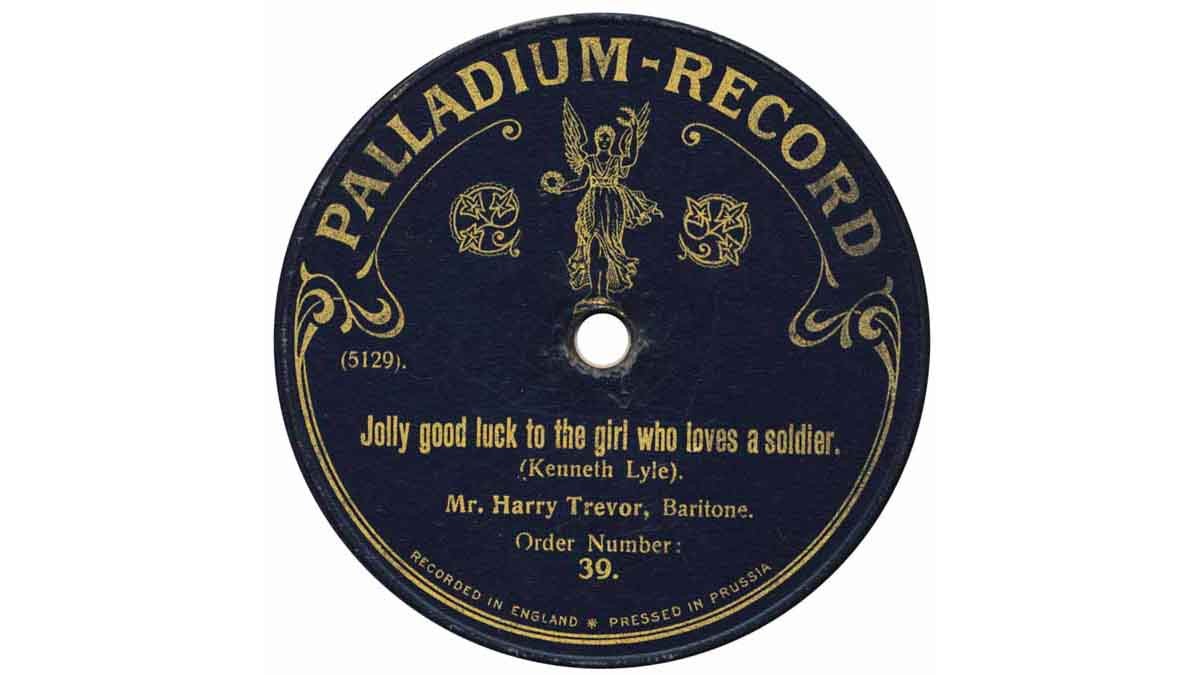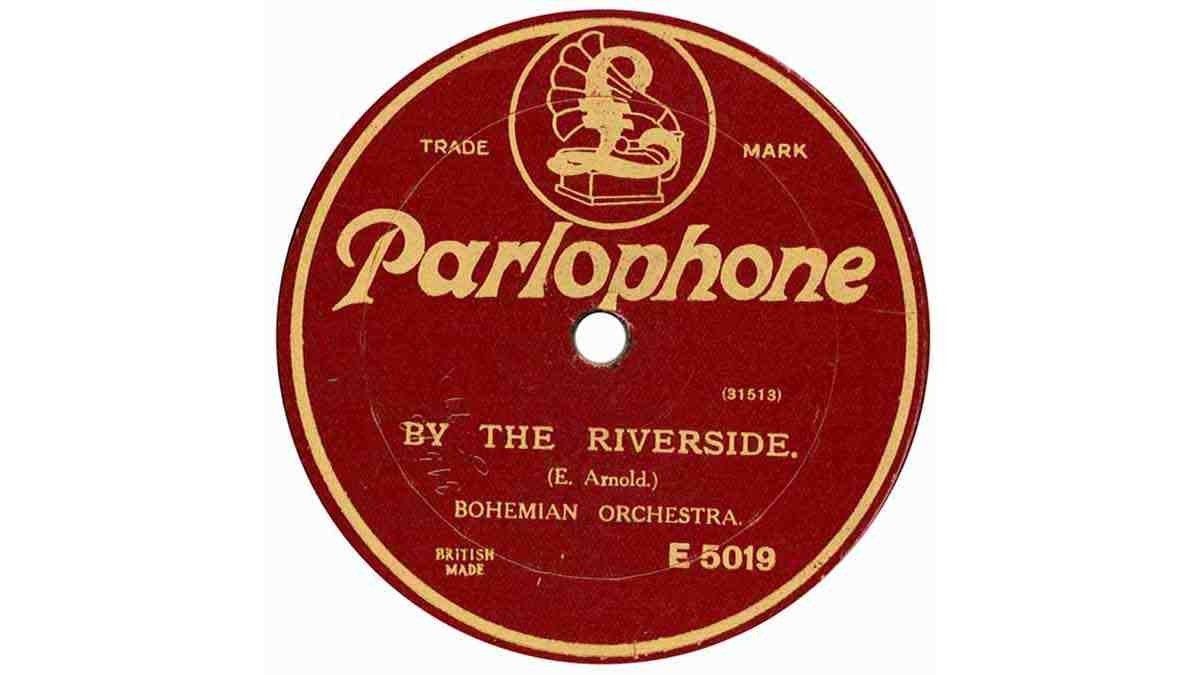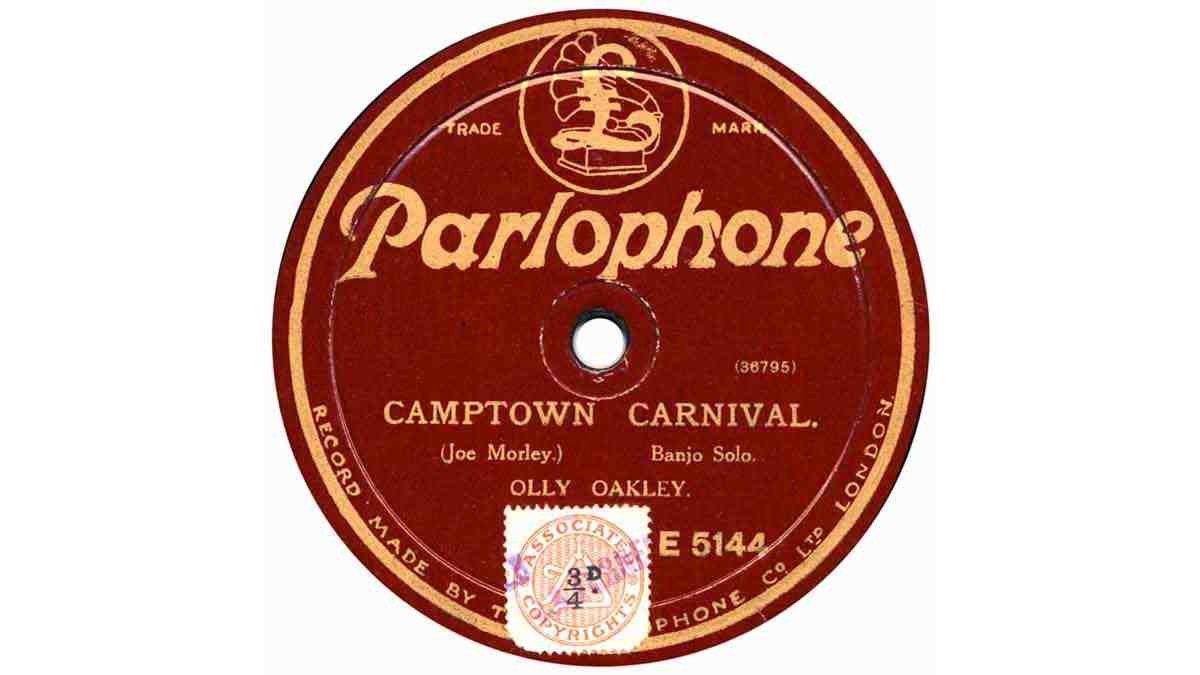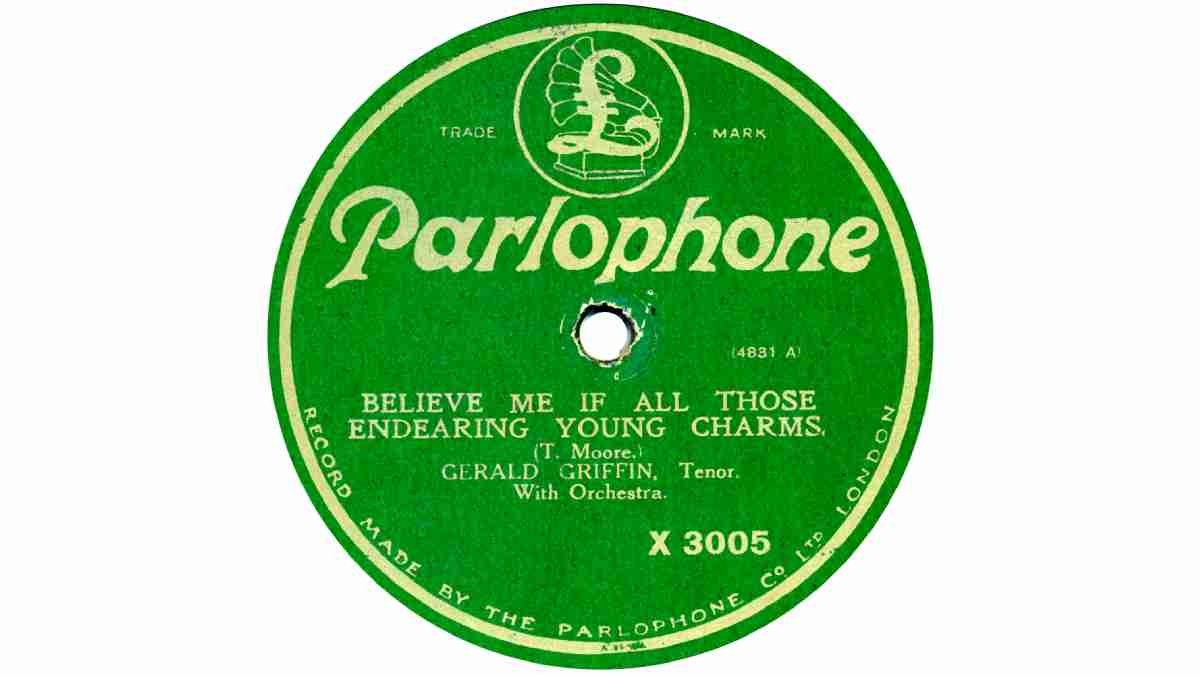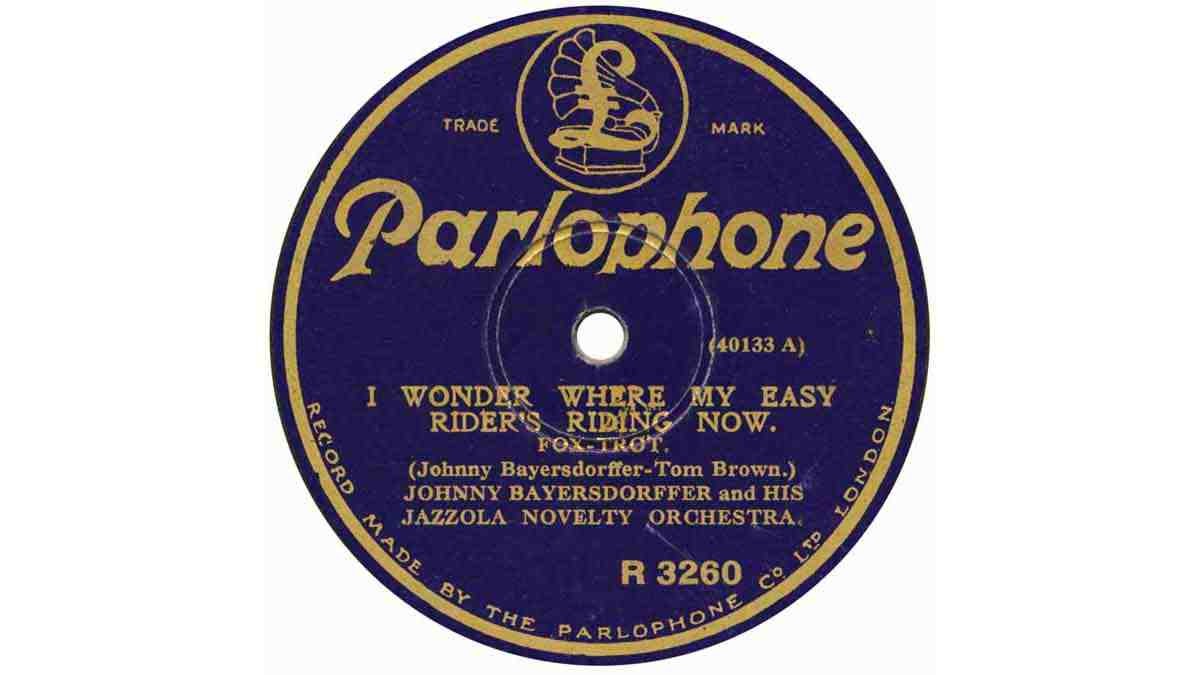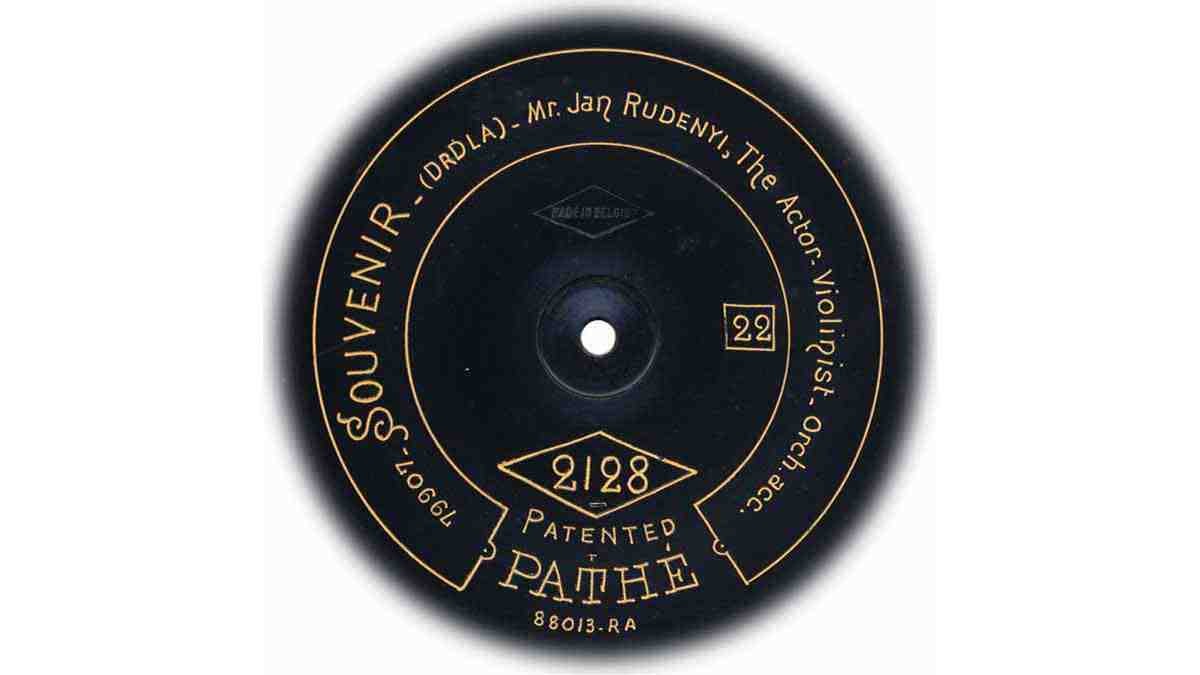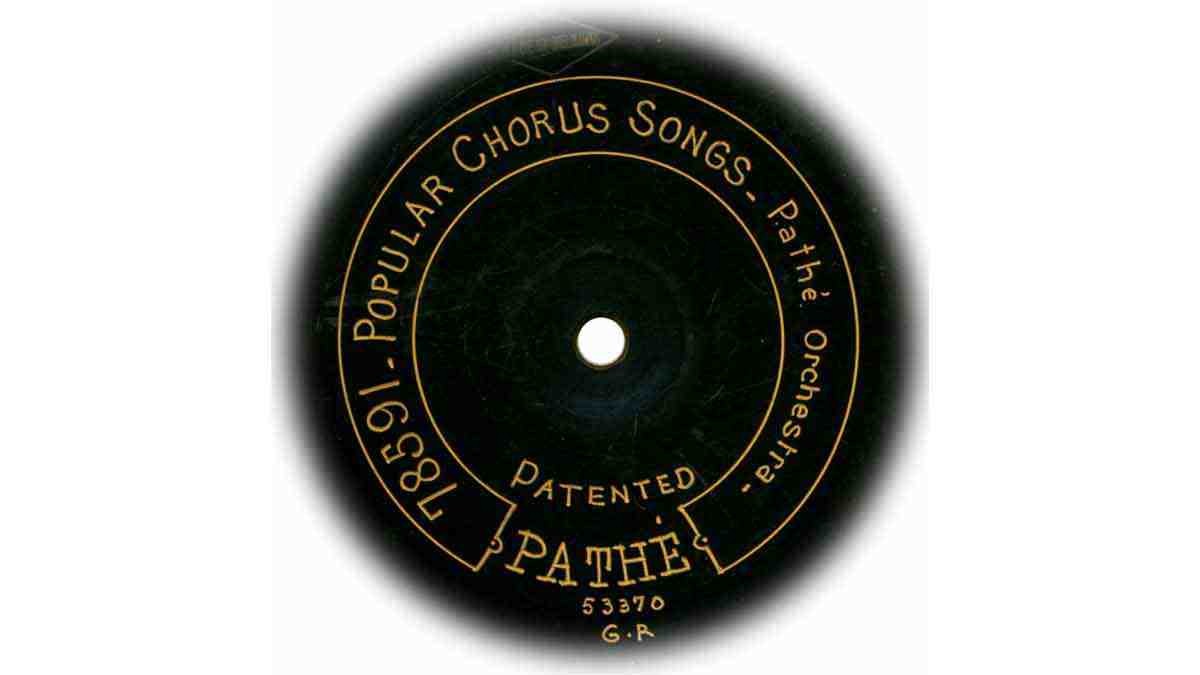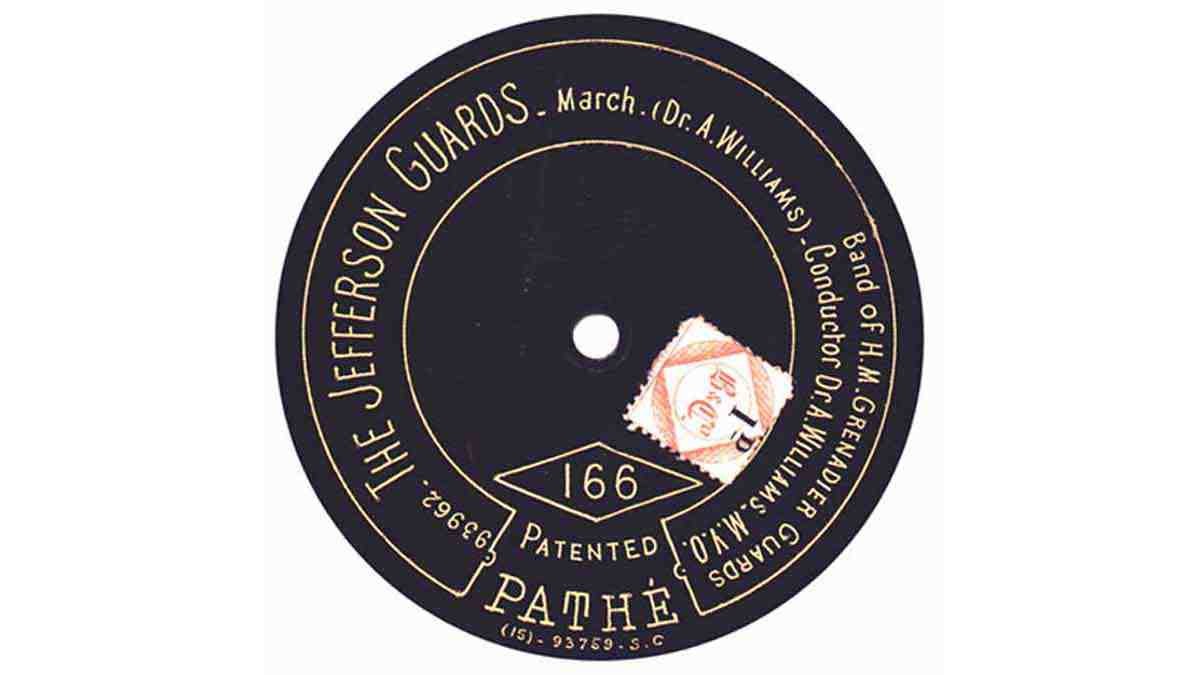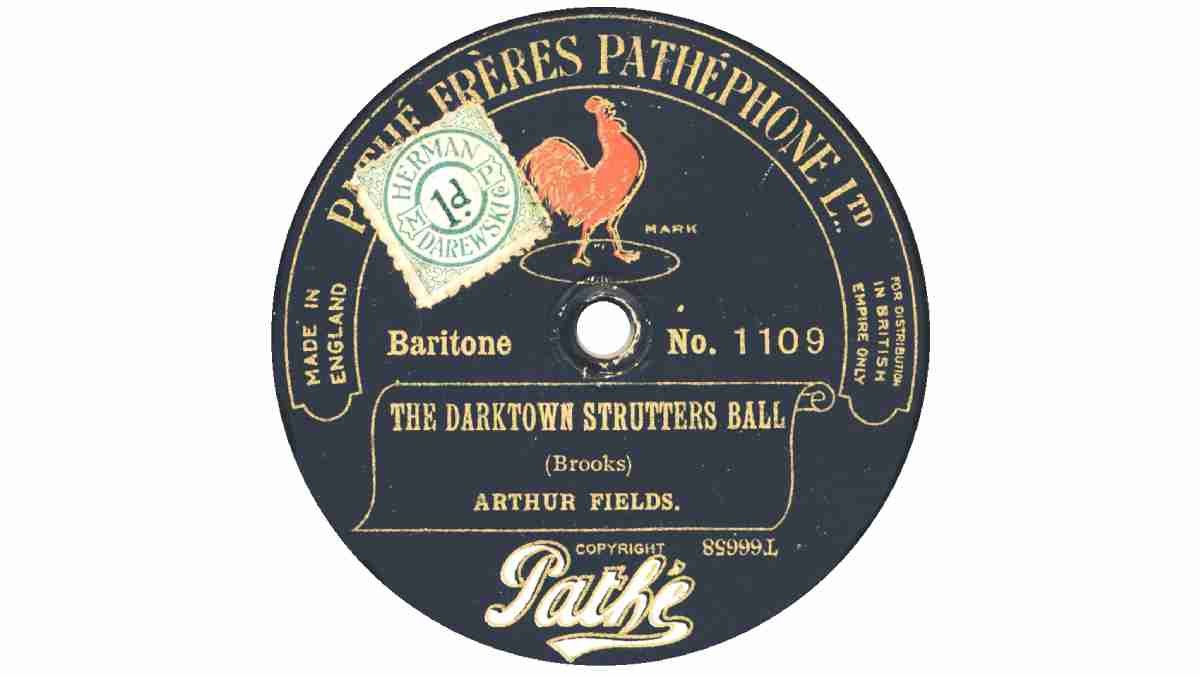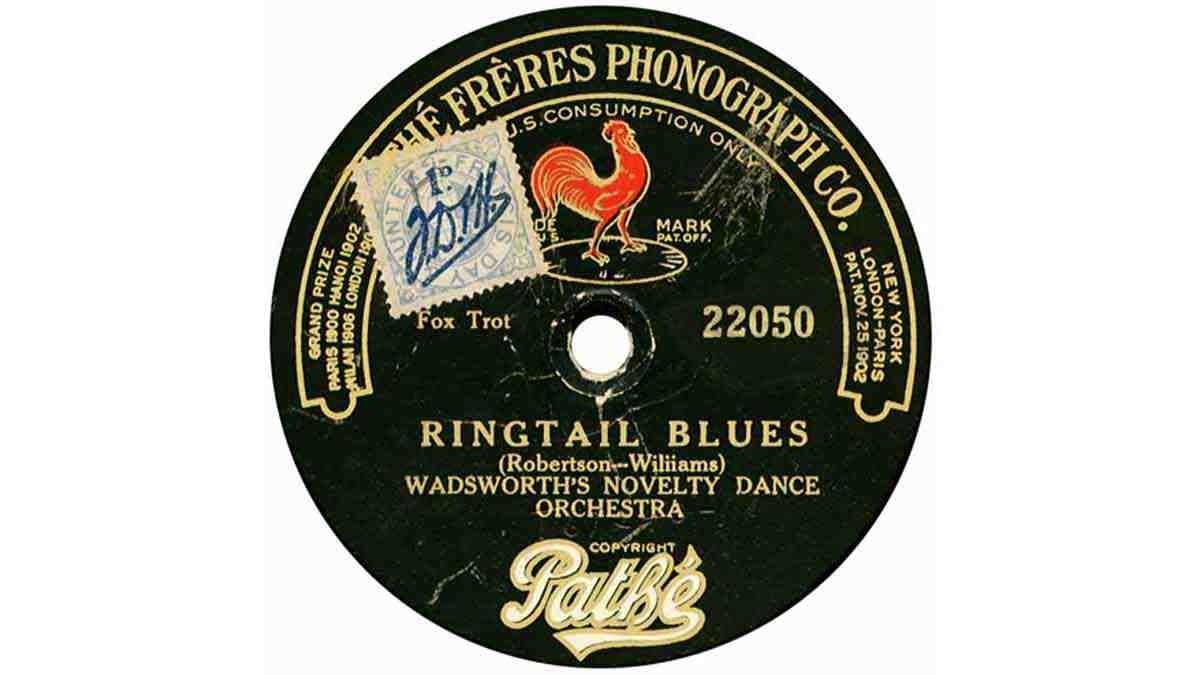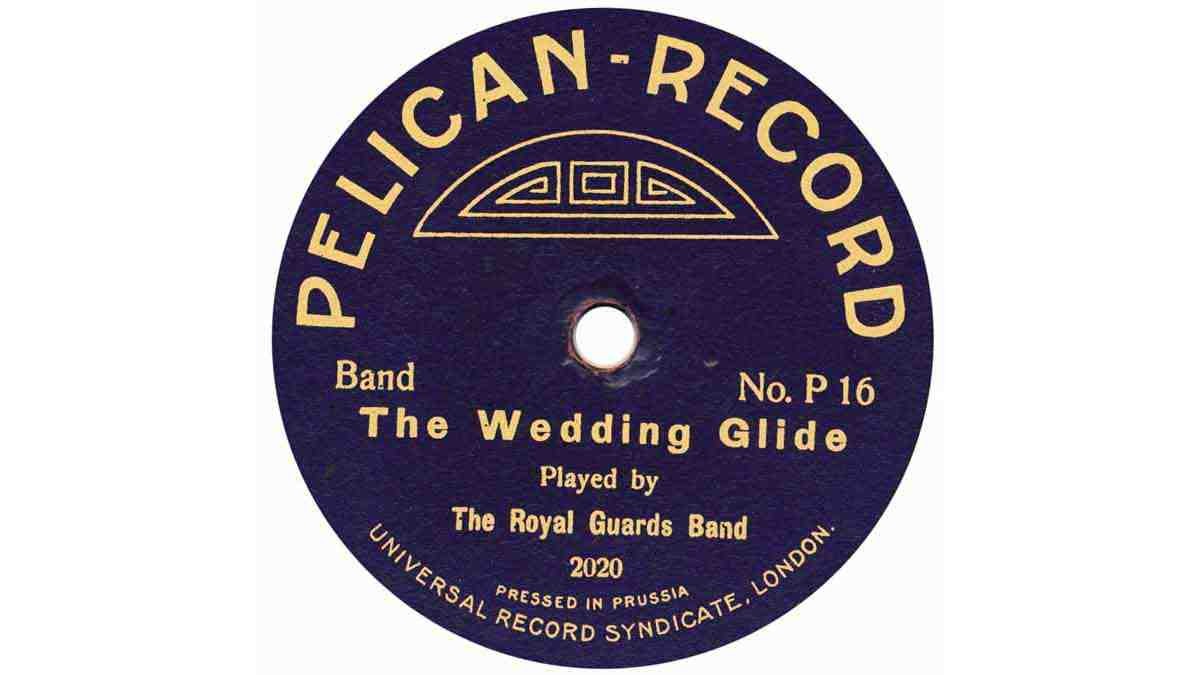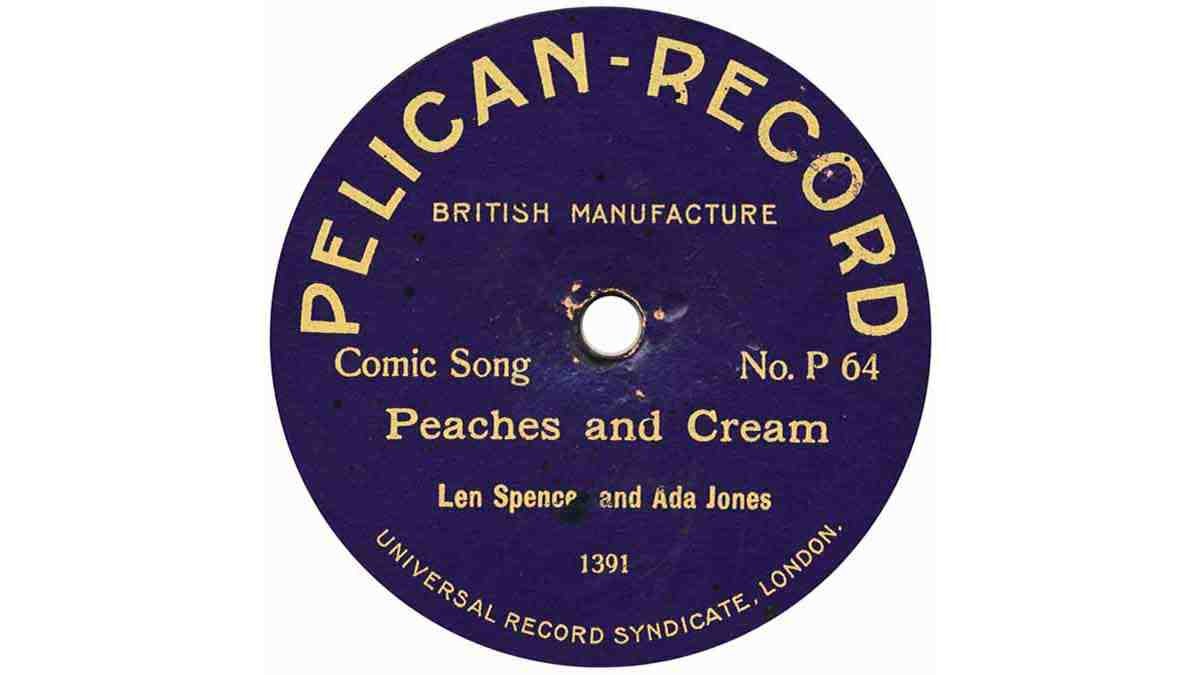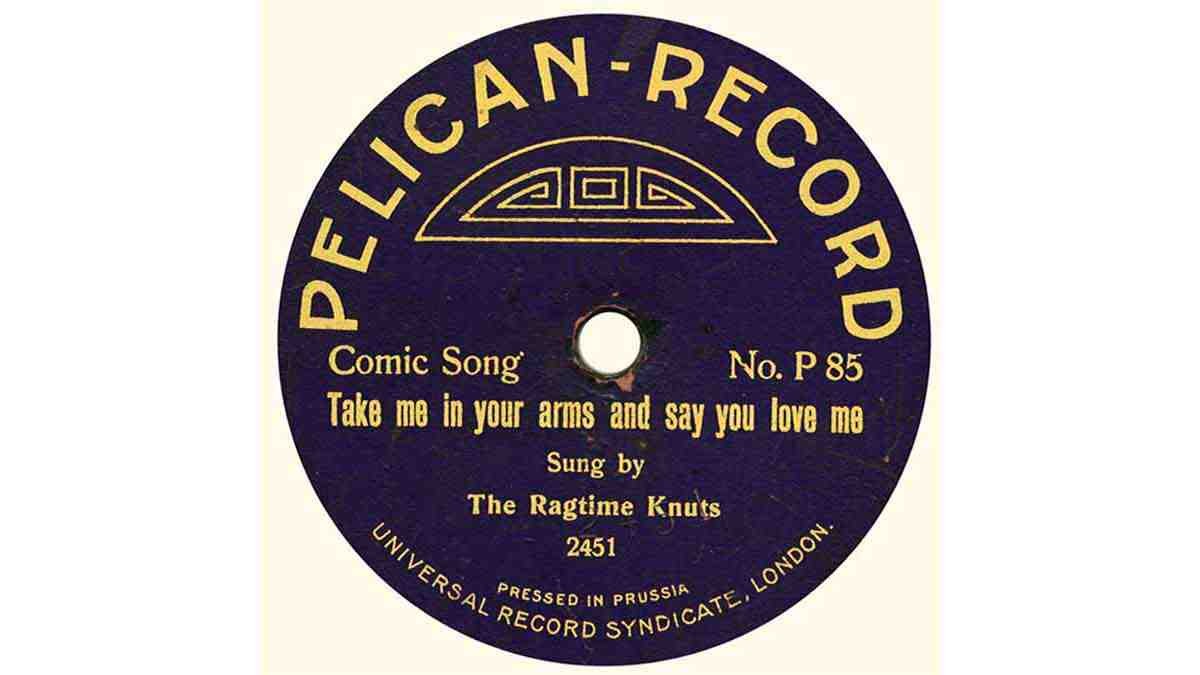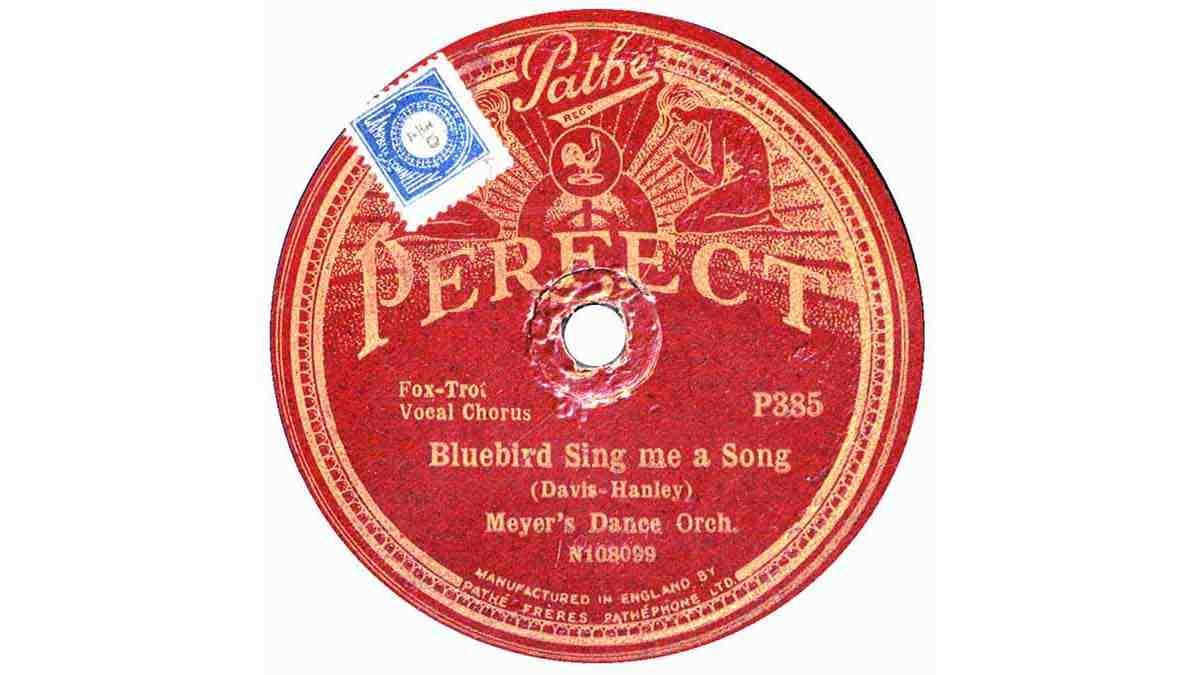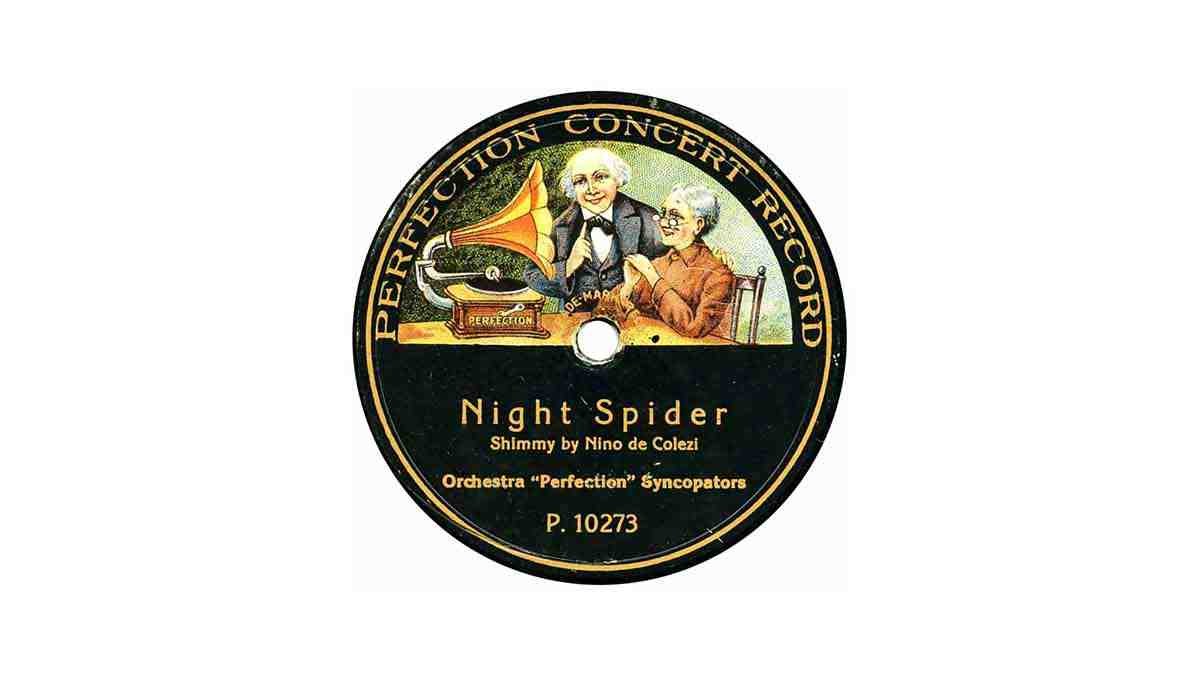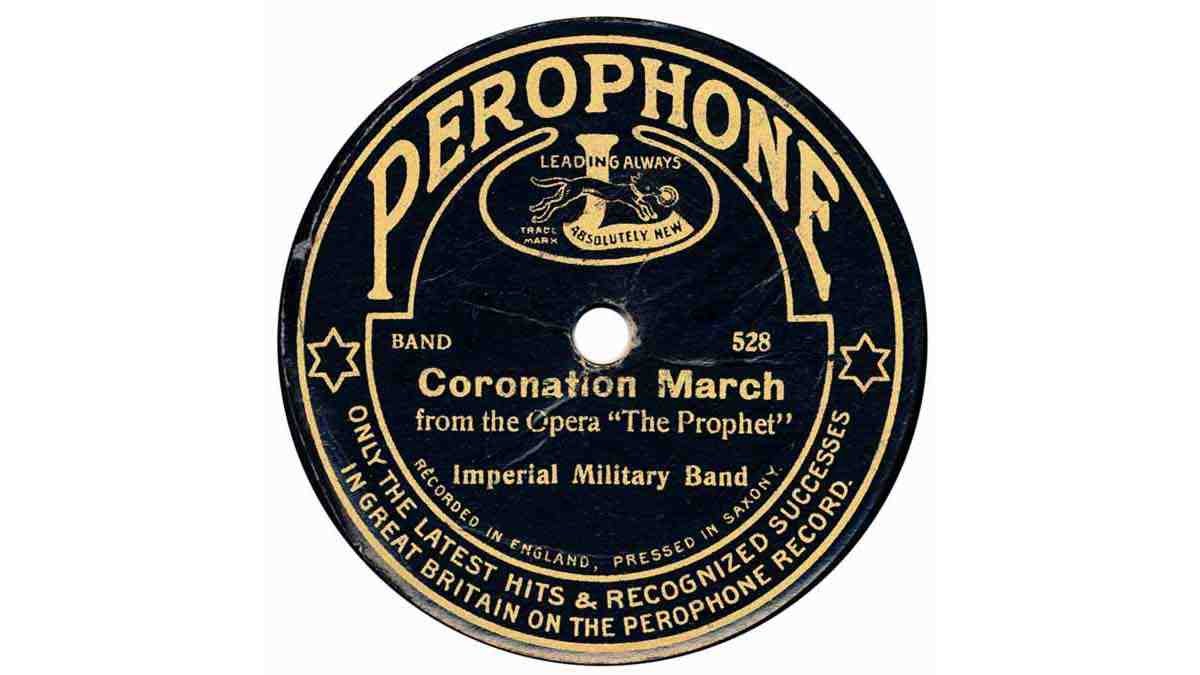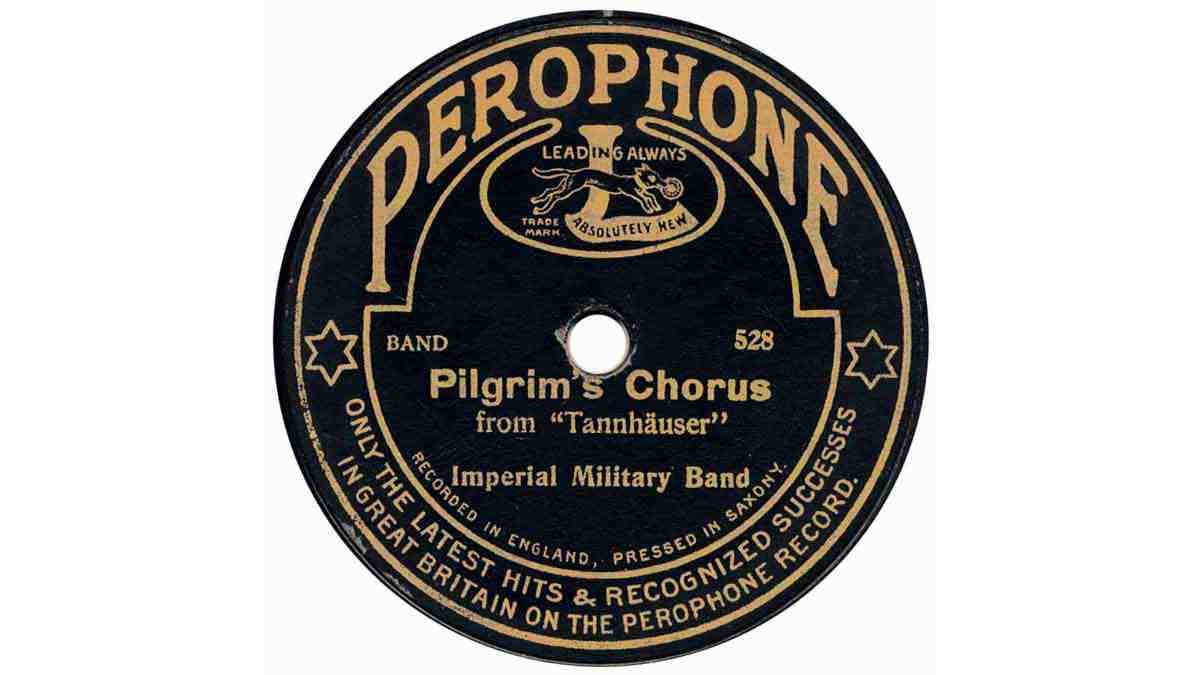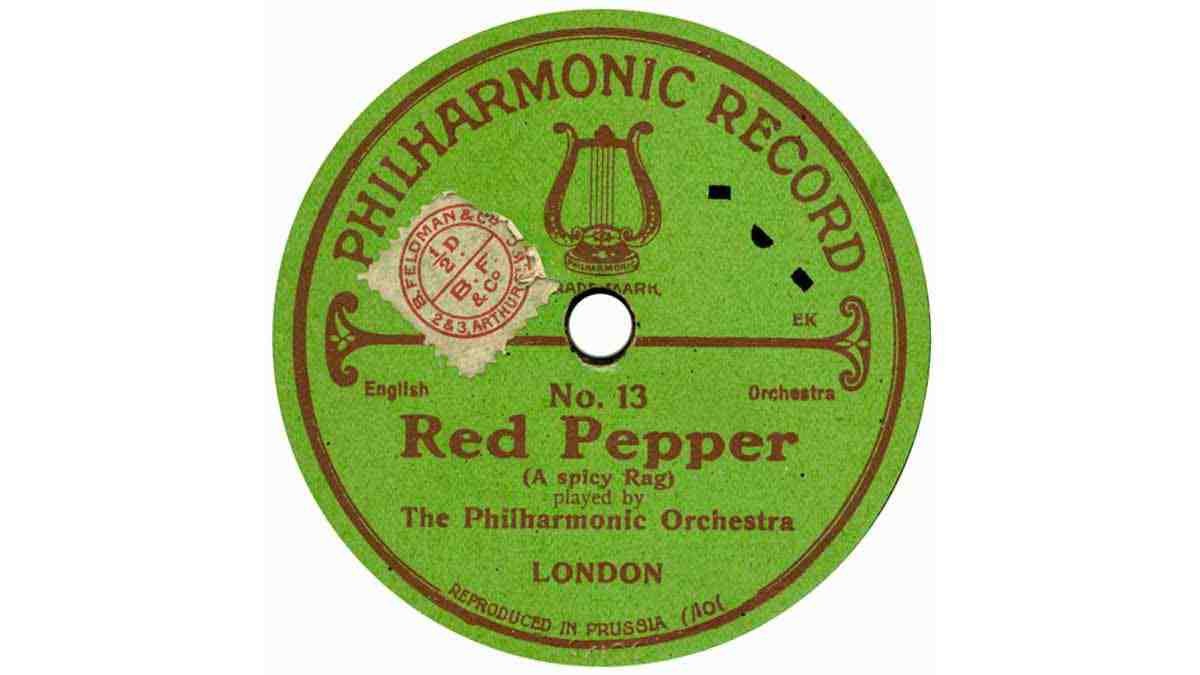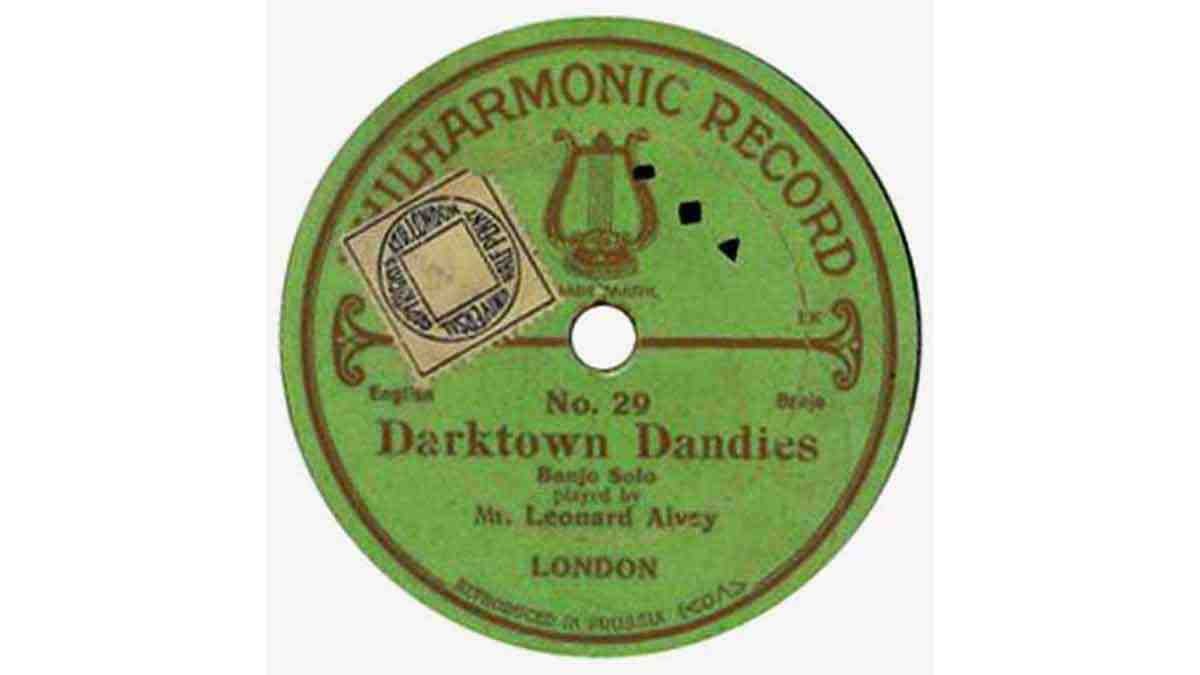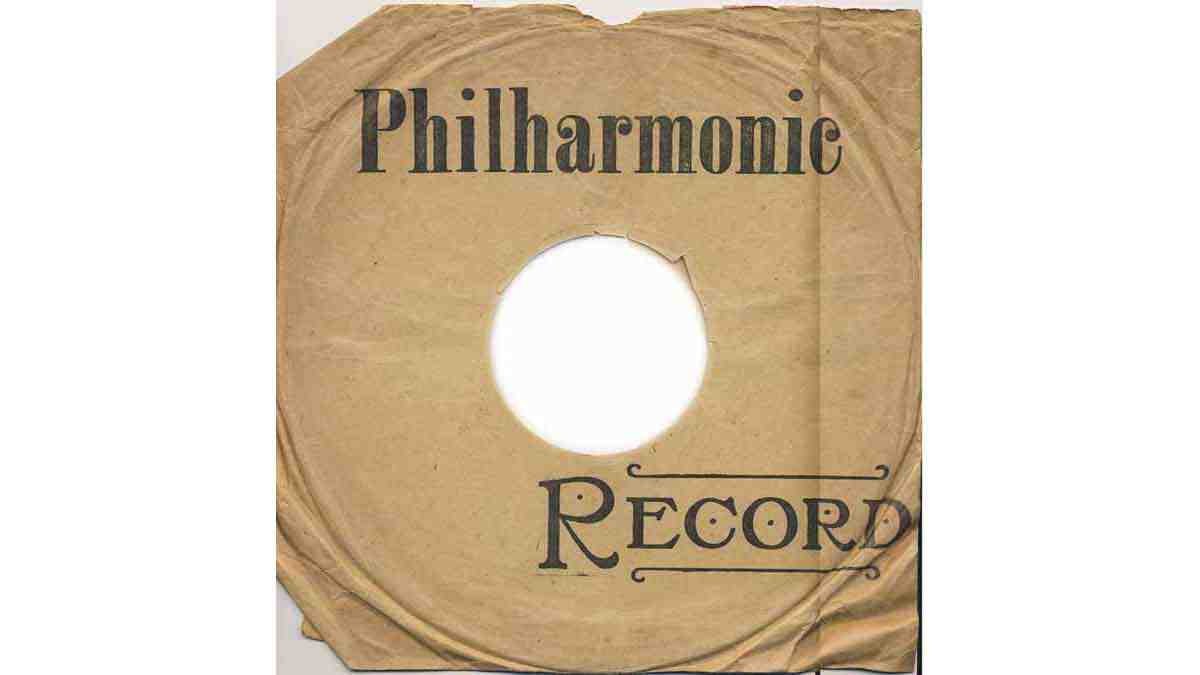
Early British record labels 1898-1926: P
Palaise de Danse | Palladium | Parlaphone | Partophone | Pathé | Pavilion | Peerless | Pelican | Perfect 1 | Perfect 2 | Perfection Concert | Perla | Perophone | Phaenomen | Philharmonic | Phoebus | Phœnix | Phona-Disc | Phoneto | Phono (Disque à saphir) | Phonothek | Pickofall | Pigmy | Pilot 1 | Pilot 2 | Pinnacle | Pioneer 1 | Pioneer 2 | Popular | Portland | Playwell | Polyphon | Popular Ballot | Premier | Possum
Palaise de Danse
Dr. Rainer Lotz kindly sent this German-manufactured label. It is one of an interesting – and suprisingly large – class of labels which bear multi-lingual titling. There was clearly an intention that such discs might be marketed by a factor or merchant, in all or any of the countries in which the language was used. It is not usually possible to establish which countries the discs actually were sold in; therefore, all are included in these pages. As to date, we can only suggest circa 1914, as that is when the tango became popular in Europe.
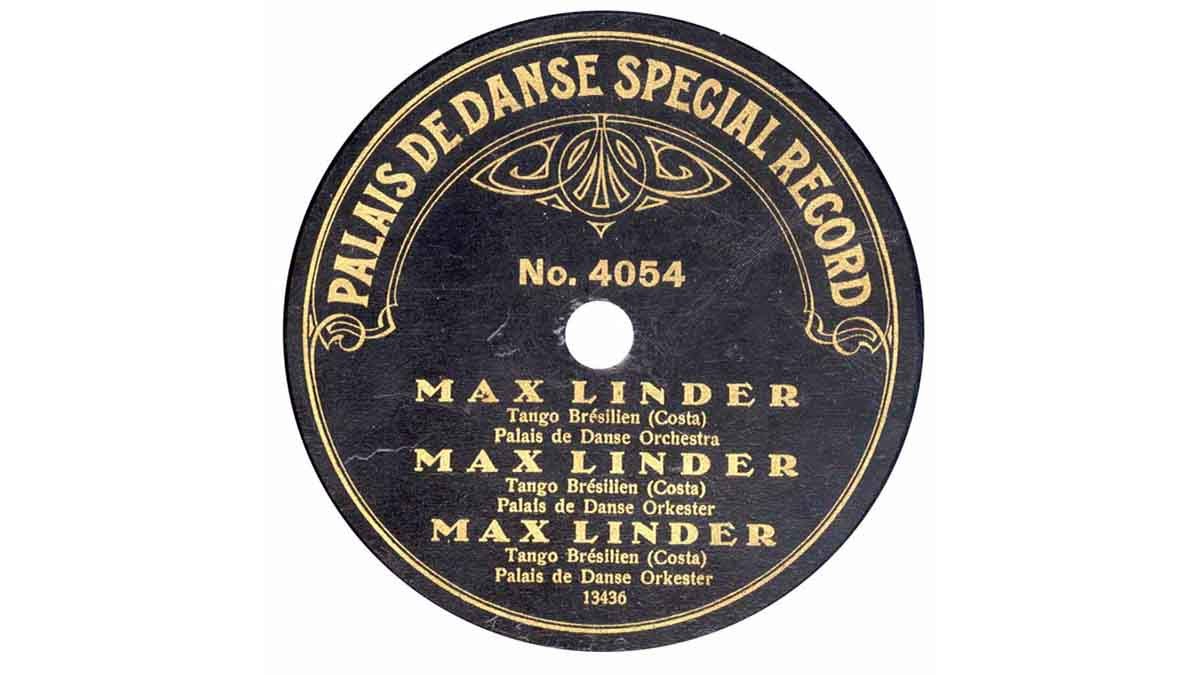
Palladium
See Frank Andrews, FTR 28. At some time during 1913, an unknown concern had Palladium Records made. Frank tells us that Polyphon had applied for ‘Palladium’ as a registered trade mark in 1912, but he can find no evidence that it was granted to them. These very scarce discs are related to Operaphone and Pavilion records, as they use the same masters and must therefore, have been pressed at the Turmalin-Derby Werke, or the Schallplatten Mass-Fabrik, both in Prussia, as the labels tell us. Masters were not specially recorded for Palladium; they were drawn from stocks of pre-existing plates, such as Dacapo and Bel Canto. Nothing is known about who sold them in the U.K.
Parlaphone
Parlophone records appeared in the U.K. in 1923. The ‘£ sign’ is actually a script L, indicating that the parent company was none other than Carl Lindström A.G. of Germany. Before the 1914-18 war, the ever-growing Lindström concern had been immensely important in the U.K. with its Beka, Odeon, Fonitipia and Jumbo discs. But in Germany it was a greater company still, and active all over the world. A few months prior to the war, it had absorbed the Lyraphone, Dacapo and Favorite concerns. It even had its own British pressing plant at Hertford, though that was confiscated by the Board of Trade in 1916. The label appeared again, as a modest re-entry into the British record market, tactfully done via the innocent-sounding Trans-Oceanic Trading Co. Ltd, based in the Netherlands. This was, in reality, a Lindström subsidiary. However, the earlier triumphs of Lindström were not to be repeated, for Lindström itself was very soon bought out by U.K. Columbia. By E-5144, we have a Parlophone Co. Ltd, London: a subsidiary of Columbia. There is an irony here: Olly Oakley’s ‘Camptown Carnival’ first appeared on Lindström’s label Jumbo in February 1917 – just after Linsdström had been taken over by the Board of Trade, and it affairs re-distributed, principally to Columbia. So we have a side made just after the fall of Lindström, re-appearing on a new label just after it had been taken over by the very same concern. The 3000 series had no less than three prefixes. X, E and R. X (short-lived) and E were mostly used for ethnic material, and the R- prefix indicated the ‘Royal Blue’ of a higher-class series containing dance music such as tangos recorded in the Argentine by Roberto Firpo. There were also highly desirable jazz issues from the U.S.A. Later, it became Parlophone’s general ‘top price’ series.
Partophone
See Frank Andrews, FTR 29. To say that Partophone records are very obscure indeed, is a gross under-statement. All Frank knows is that they were 4″ (10cm) in diameter, double sided and flexible. You know, the idea of trying to make a complete list of all early British record labels (the very purpose of these web-pages) is by no means a new idea. In 1912 such a list appeared in The Talking Machine News. It attempted to list all makes of cylinder and disc that had appeared since 1891. The list was compiled by one Lindsay A Wilcox, and included the above details of the Partophone record, but alas gave no date for it. Frank can only infer Partophones existed sometime between 1902 and 1912. Mind you, the list also includes recordings made in 1905-06 by one Bawtree on an endless celluloid band, like Dictaphones in the 1950s/60s. Things like this are the very stuff of dreams, though perhaps rather uneasy ones… How many more weird & improbable labels & formats are out there waiting to be re-discovered? I reckon quite a few, especially if we all poke about enough!
Pathé
There are three volumes available on British Pathé issues ; another masterwork by Mike Langridge’s, long-awaited. Published by the CLPGS, the first volume covers cylinders and centre start discs (468 pages), the second, edge start discs (332pages), including the ‘Diamond Disc’ produced by Pathé; and the third is devoted to the lateral-cut Actuelle label (258 pages). Go to the bookshop at www.clpgs.org.uk to check them out.
Pathé was also covered by Frank Andrews, BRI; and before that by Frank Andrews & Leonard Petts, HD 170, 171, 172, 173, 1989-90.
Briefly, Pathé discs first appeared in 1906, single sided, vertically cut and centre start. Soon double sided, they came in several sizes, including 20″ (50 cm). In this country, those giants were not long-playing discs; they were simply louder because they ran at around 120 rpm. (About 1913, Pathé did make a 50cm long playing disc running at 60 rpm, but those were not marketed here.) Pathé continued as such until their factory in Belgium became inaccessible to them in the Great War. The Diamond Record Co. was taken over as a new British replacement, but did not flourish. The label was re-launched in 1919, still vertically cut, but starting at the outer edge. They did well at this time, and were forced to import discs from their U.S. branch, as the British factory could not keep up with the demand: 22050 says ‘For U.S. Consumption Only’, yet it bears a British copyright stamp, attesting to its sale here. Lateral cut discs followed in 1920 – see Actuelle. Pathé also did contract pressing for other labels, e.g. early Brunswicks. They also supplied ‘finished products’, including the C- series Homochords, some Graftons and some Scala Ideals, pressed from Pathé’s own masters. In spite of all this, the French parent company withdrew from the U.K. record trade in 1928, apparently never having made any profit from their twenty years of disc production in the U.K!
Pavilion
See Frank Andrews, FTR 29, 2009. Yet another excessively rare label which Frank informs us is related to Palladium and Operaphone. They all used the same pool of pre-existing masters; and Pavilions seem to have the same catalogue numbers as the Palladium. Even Frank has details of only two of these elusive discs. Pressed in Germany either by Tourmalin-Derby or the Schallplatten Mass Fabrik, they probably appeared in September 1913 and ran only to August 1914. Nothing is known of who sold them. Frank also reports that they were never advertised in the trade press; this tends to indicate a ‘tallyman’ operation (see John Bull or Meloto for explanation).
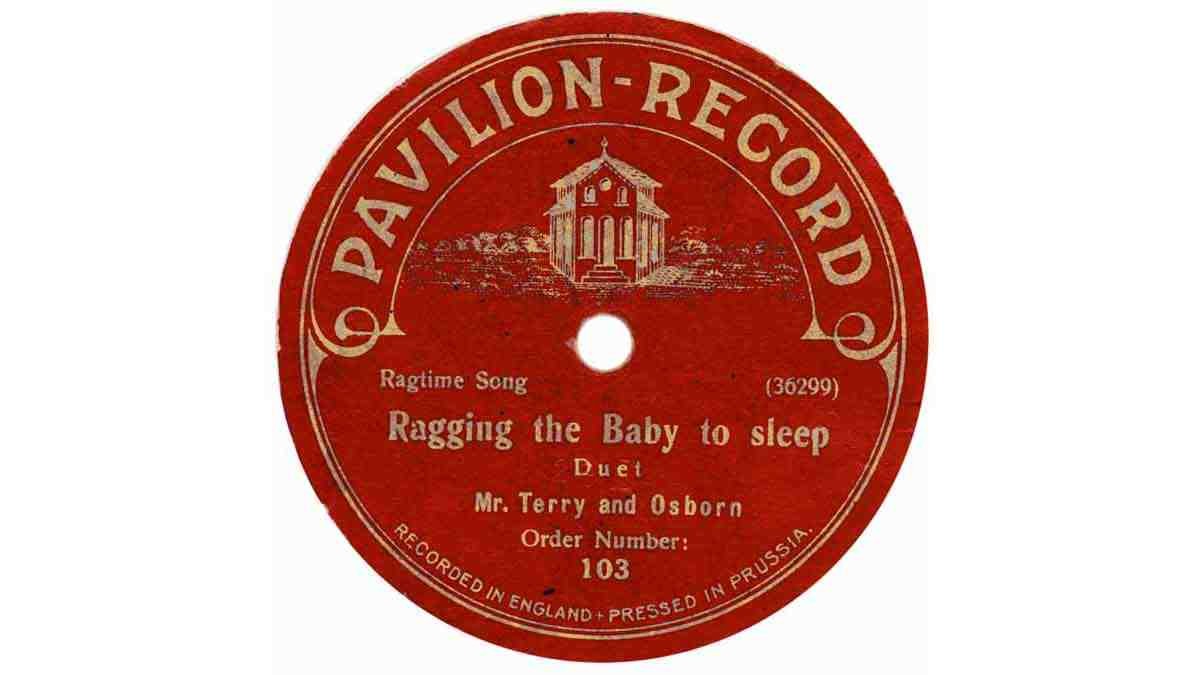
Peerless
See Frank Andrews, FTR 29, 2009. It is not known who sold Peerless records. The title and artiste details (without a catalogue number) were typed onto the label before it was stuck over surplus records, bought cheaply, possibly from the originating company, but also maybe from the stock of a failed dealer. Frank knows of Cinch and Zonophone discs overstuck with Peerless labels. The date range is unlikely to be before 1915, and more likely to be nearer or even after the end of the Great War in 1918. Indeed, the example above, Zonophone 1983, was recorded around the middle of 1919. The copyright stamp peeps, forlornly, from under the Peerless label.
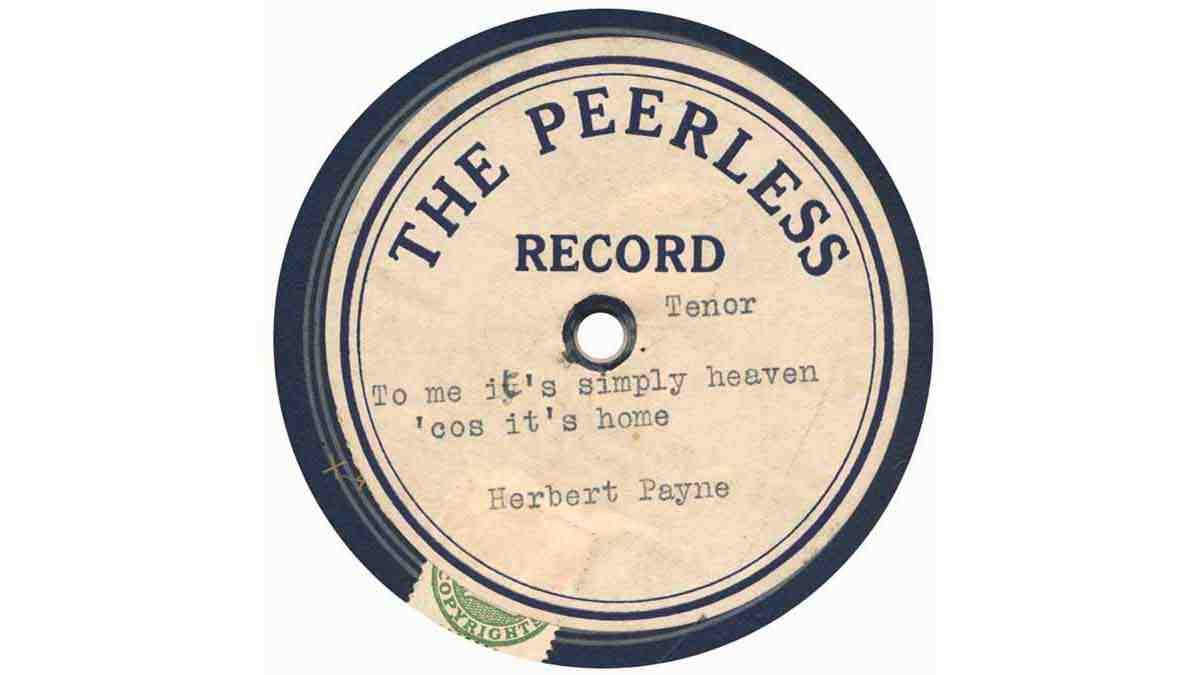
Pelican
See Frank Andrews: FTR 29, 2009. Frank tells us an exact date for the appearance of Pelican discs: 15th September 1913. Exactly who the ‘Universal Record Syndicate’ were is unknown, even to Frank. At first they were manufactured in Prussia. Later, they were made by The Disc Record Co., Ltd. factory in Kenton, Middlesex. These came from a variety of sources: Nicole; Diploma and U.S. masters from Star and The American Record Co. Cf. P-64 – which also has no ornament below the name. The numbers range from P-1 to at least P-116. These were records made down to the lowest possible price: just one shilling (5p). A price war had been raging for some time, reaching a fierce climax in the 1913-1914 season. Even major companies like The Gramophone Co., and Columbia had been forced to enter the cheap market with their Cinch and Phoenix labels which sold at the hitherto unbelievably low price of 1s 1d. These may even have been sold below cost – or very little above it – as an attempt to drive their smaller competitors out of business. Frank states that the Disc Record Co. could not keep up with the demand for Pelicans; apparently they could only press 200 a day, or 300 if they worked an extra shift. (Note. Query this; the DRC claimed an output of 3000 a day well before this date…) Pelican does not seem to have survived much after say the end of 1914. They are (or used to be) found from time to time. Notice that ‘Pressed in Prussia’ on P-108 has been gouged out, doubtless by an indignant Briton, after August 4th 1914.
Perfect 1
See Frank Andrews, FTR 29, 2009. Another very obscure marque. Frank does not know who had them made. He has only two of them listed; and the four sides are from three different sources! One disc bears two U.S. sides from the old American Record, while the other couples a Bel Canto master with one from Beka. Both the latter had been issued on John Bull. These heterogeneous sources allow Frank to deduce that the Perfect Record was pressed from the master pool held by the Disc Record Co. Ltd., at their factory in Rosslyn Crescent, Harrow, just like Pelican above. The time period would be similar; 1912 at the earliest, and the beginning of 1915 at the latest, when the DRC folded.
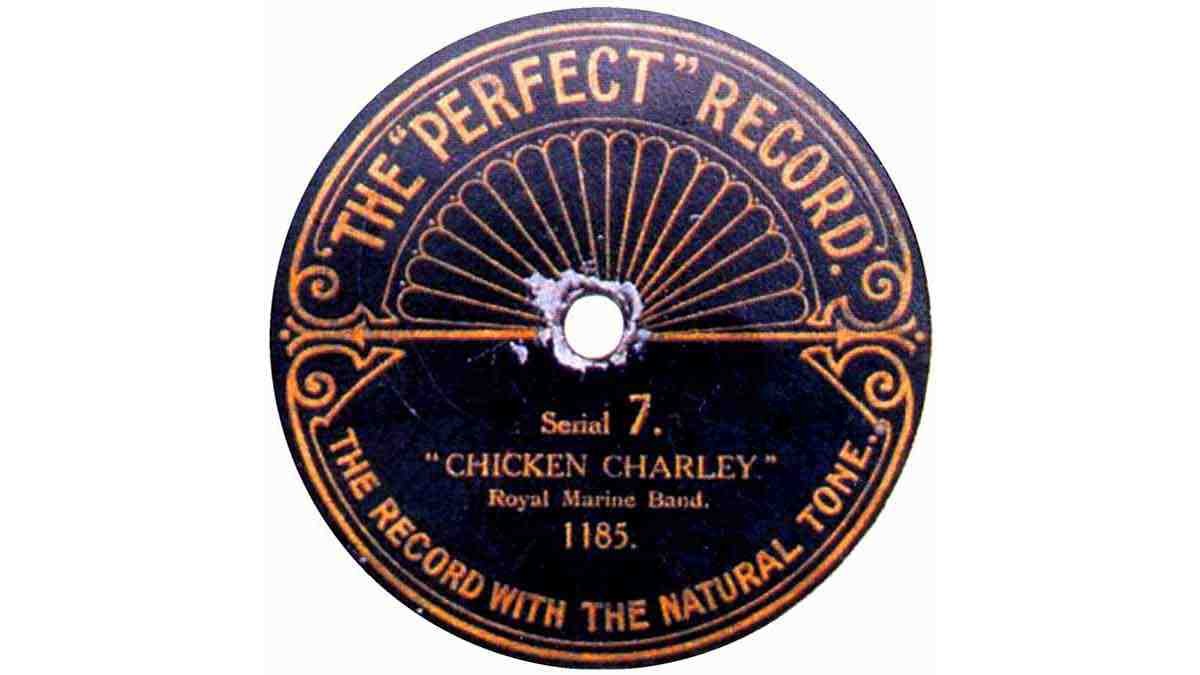
Perfect 2
British Pathé introduced a cheap line in December 1927 with ‘Perfect’, a name they had been using for some years in the U.S.A. for budget price discs. This label only just qualifies for inclusion here, as there seems to be only one disc that was mechanically recorded – and we have not yet found out which one it is. Perfect was short-lived; a year later, Pathé withdrew from the record market in the U.K., so Perfect and its more up-market sister Actuelle, disappeared. The Pathé interests had been largely taken over by Columbia, who were kind enough to press the last Perfects in their own factory, accounting for the Columbia-like appearance of P433. (The highest number is P435.) It has the Columbia centring ring, and is a high quality laminated pressing. (It’s electrically recorded so shouldn’t really be here – but it’s an interesting curio, isn’t it?)
Perfection Concert
See front cover of FTR 30, 2009, and letter from Roger Mackey on p354. Dr. Rainer Lotz kindly sent us the first example. The disquieting title ‘Night Spider’ is labelled as a ‘shimmy’, which dates it to the early 1920s. This is almost certainly a German recording. We are also very grateful to Roger Mackey for sending us the other example. Recorded in Bucharest, it was clearly manufactured in Germany by Homocord, as it bears dates in the form J22W = 22nd September 1926 (probably the mother plating date); and also A 11 11 26 = 11th November 1926, (probably the stamper plating date). The year-letter W is very interesting. You see, Homophon/Homocord had a letter date code that started at Z for 1901, and ran backwards, attaining the letter A in 1925. (See homophone.htm if you really want to get into all this.) But no discs were made until 1905 – letter V – so Z, Y, X & W had not been used. When A was reached in 1925, consternation reigned. What should be done? Somebody with a longish memory probably recalled that W, X, Y & Z had not been used. So W was used for 1926, as here. Alas, it should have been Z, as the year letter always went backwards. The dawn of 1927 brought (I conjecture) an irresolvable crisis, which seems to have resulted in the abandonment of year-letters. As far as I know, there is no Homocord with a Z, Y or X for the year. No: the symmetry of the system had been irrevocably disrupted. We possess a 1927 Homocord test pressing that still has a stamper plating date in the usual form; but as to the rest, there is simply the mundane ‘Mechan Copt 1927’ in the wax. Both of these labels are included here because they bear titling in English, and it is therefore assumed that at least, an intention to sell them here may have existed. There are many such multi-lingual labels, and it is not possible to know how many of these actually made it to the U.K. Therefore, all such discs appear in these pages.
Perla
A label with trilingual titling including English; so whoever made it – an unknown German company – could say to a factor (wholesaler) “You could sell this record in several different countries.” There are quite a few labels of this type, and while there is little evidence that any of them actually were offered for sale here, all are included in these pages, just in case!
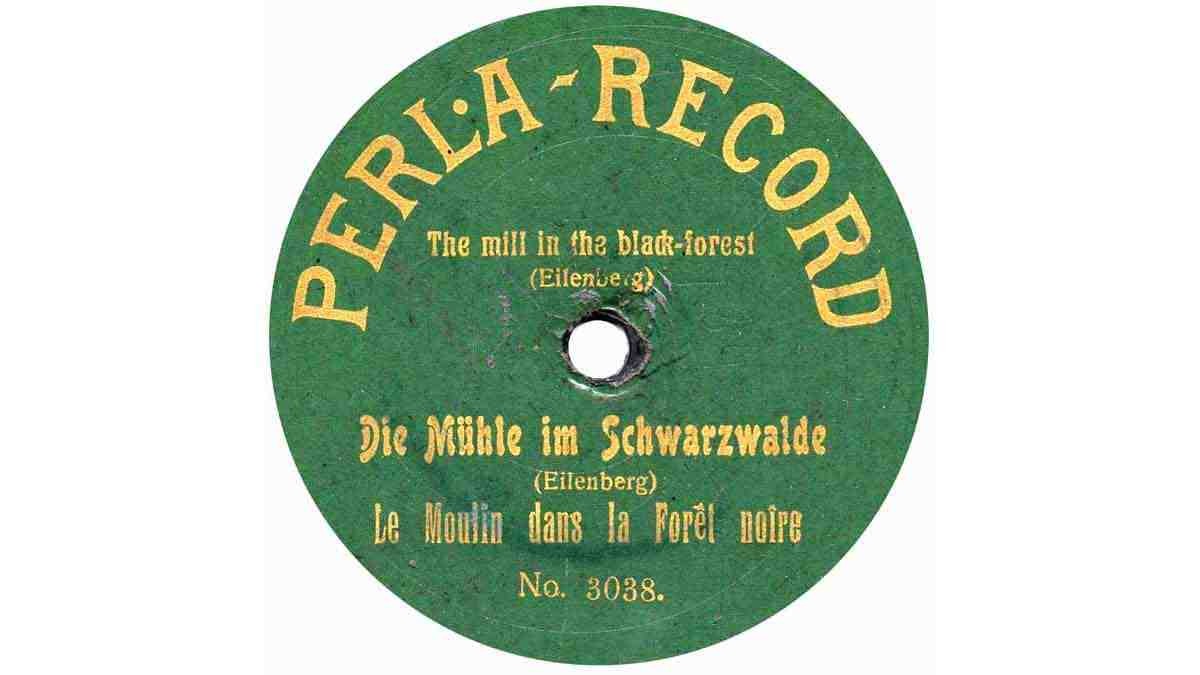
Perophone
See Frank Andrews, FTR 30, 2009. This label was distributed by Lockwoods, and bears the logo of that company, which can be seen on other Lockwood’s labels, e.g. Colonial and Colonial Perophone. These last two were for export only, so we assume that ‘Perophone’ itself was for consumption within the U.K. The logo is a letter L with a greyhound leaping across it, holding a record in its mouth, plus the slogans ‘Always Leading’ and ‘Absolutely New’. In fact, Perophones were pressed by Favorite, and Frank suggests they may have first appeared in early 1908 – but even he does not know how long they were in production. They are not common. Indeed, we have only just (March 2013) acquired one, as above. The label was not pressed into the disc, and so must be stuck over another. Half an hour’s slow work with cotton buds revealed that there was nothing untoward going on. We removed the Coronation March label above, to reveal ‘Pilgrims’ Chorus’ from ‘Tannhäuser’, shown above. This is the other side of this disc. So it’s merely a case of reversed labels. Presumably a batch of Perophone 528 were pressed thus, and somebody, somewhere – probably Favorite, a conscientious firm – over-stuck the right ones. We were slightly disappointed; for after all, ‘Good news is no news’.
Phaenomen
Another example of multi-lingual titling on an German-made disc. A precise date is hard to ascribe to these sort of records, for they were manifestly intended for a wide circulation in several European countries. Because of this, the repertoire on them was of a versatile nature, as here. Mascagni’s opera ‘Cavalleria Rusticana’ was first performed in Rome in 1890, and has been universally popular ever since. A recording of its overture would have had a ready market all over Europe, and beyond. A guesstimate would be 1908 – 1912. The disc is included here because, though we do not know for sure, it might have been imported.
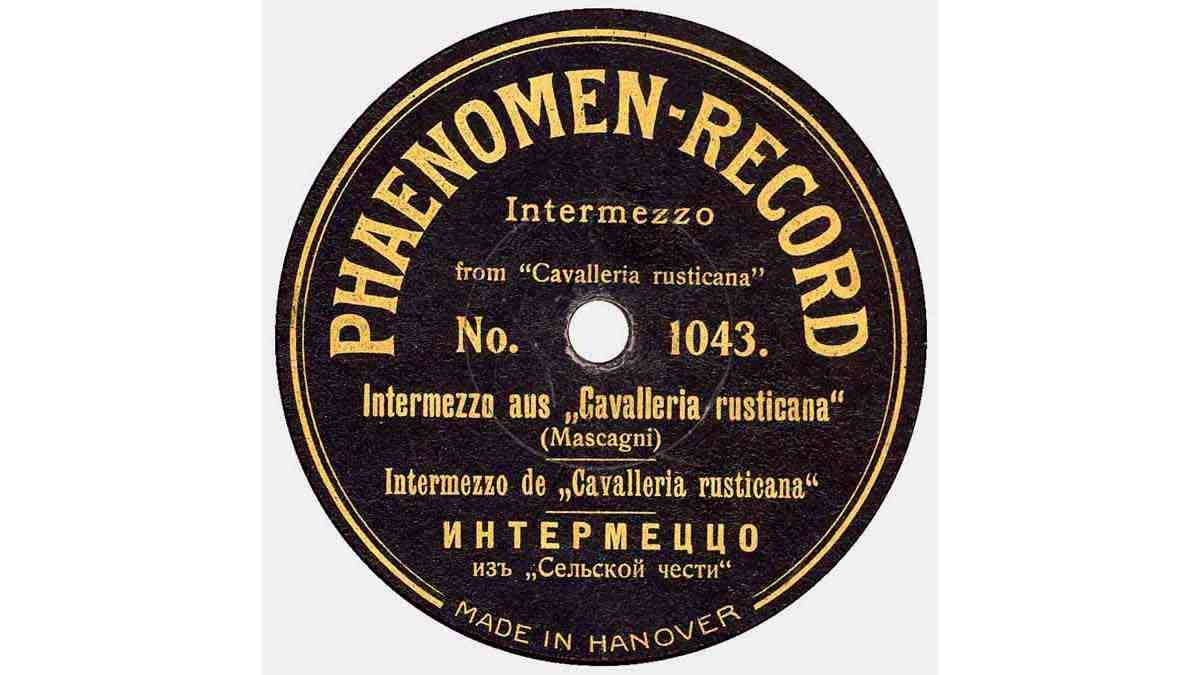
Philharmonic
See Frank Andrews: FTR 30, 2009. This was a Manchester based label. Pressed in Germany by Favorite and using their own masters (notice the shapes punched out in the labels), the first 87 issues were available by April 1913. By September 144 had appeared, but even though they were good value at 1s 6d (7.5p), the Price War took the price of top-quality products (as well as mediocre ones!) down to 1s 1d and even 1/- (one shilling, 5p). Philharmonics were not mentioned in the trade press subsequently, and we may presume they just faded away. This is a very scarce label, and for years I counted myself lucky even to have found an empty packet. Although, having said that, name-bearing packets of this early period are much rarer than the discs they contained.
Phoebus
See Frank Andrews, FTR 30, 2009. ‘A Catalogue of Clarion & Ebonoid Records’, E Bayly Sr. & Frank Andrews, Bournemouth 1977, may contain relevant information, as used below. Fourteen Phoebus discs were announced in October 1908, by Lacroix & Co., Jewin Street, London. At the same time, they announced the vertical cut ‘Phono’ record (see ‘Phono’ below). Both of these were manufactured in France by the Compagnie Internationale Phonétique, (C.I.P.). The sales of both labels must have been truly microscopic: they are extremely rare. Much rarer even than Neophone – which is saying something. We are very grateful to Mike Atkin and Paul Kilmartin for providing images. (Paul lives in New Zealand, and his father made a large collection, many years ago, when the interest in ‘old labels’ scarcely existed. It contains TWO Phoebus discs!) Lacroix soon gave up the agency, which was taken over by a Mr. Davis, but nothing further is known. However, both Phoebus and Phono carry recordings of British artistes. Who made these, and where? A clue resides in the space between the groove and the label:
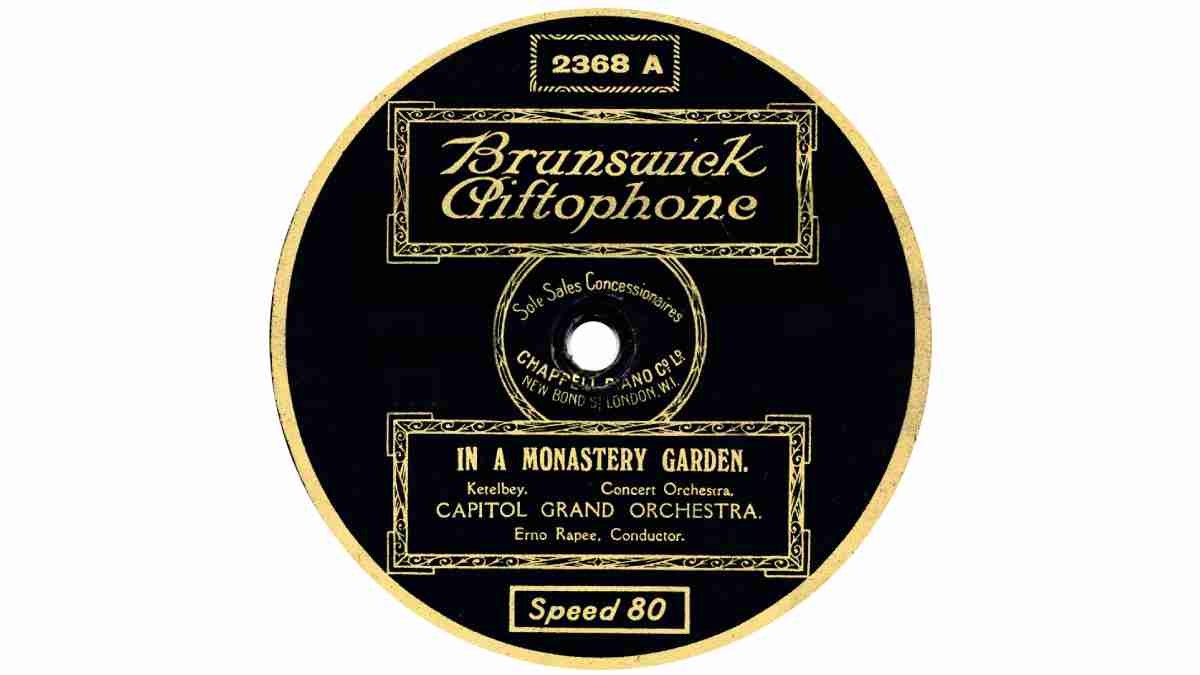
Phœnix
See Frank Andrews: FTR 30, 2009. The Phœnix Record Co. was a wing of what, for convenience, we may call Columbia. With the flood of mostly German-pressed discs driving the price ever downwards, major companies were forced to produce their own cheap discs. The record and gramophone trade was of course seasonal – the summer being the ‘off-period’. The opening, in September, of the 1913-14 season saw the most bitter (and indeed the last) battles of this Price War. Phœnix records, produced to the same high standards as Columbia discs themselves, began at O1 at this time, and the price was just 1s. 1d. They generally have no numbers in the wax or under the label, just a substitute master or control number on the label in an X- series. Frank believes that initially, original recordings were made for Phœnix, and are designated by numbers X-1 onwards; and that another series beginning at X-500 denotes sides that had already been out on Columbia. Probably in order to have large stocks ready, some Phœnices (?) 8^) were pressed by U.S. Columbia, and say so on the label, as in O75 above. In such cases, the master number appears in type under the label, as was the custom for U.S. Columbia at that time. Frank tells us that by December 1914, about 229 Phœnixes had appeared, and they then ceased. However the label was revived in 1916, in order to dispose of surplus stocks of Regal, Columbia and the earlier Columbia-Rena discs. The Phœnix labels were simply pasted over the original ones. On O334 above, the red edge of the Regal label can be seen; and I have removed the label from the other side, which is revealed as Regal G-6452. Columbia must have had a good many records to shift in this way, as Frank knows of Phœnix O1023. Because of their cheapness and the high quality of their material (and recording!) Phœnix sold well, and they are quite frequently seen to this day..

Phona-Disc
The C.L.P.G.S. Reference Series booklet No.41 carries a detailed written history of Edison Bell, by Frank Andrews and Bill Dean-Myatt. It contains a CD-ROM having nearly 17,000 Edison Bell masters (Bell Disc, Electron, Radio &c as well as Winner) listed in a MS Excel file, fully searchable & sortable. Go to www.clpgs.org.uk/reference-series for more info & other such ‘new wave’ label listings.
The company loosely referred to by collectors as ‘Edison Bell’ finally entered the disc record market in 1908, with two quite different sorts. The Bell Disc was a 10.25″ (26 cm) lateral cut disc which did very well from the start and need not detain us. The other one, Phona-Disc, was launched in November 1908 and fared badly. Indeed, so rare are they, that they cannot really be said to have ‘fared’ at all; rather, they just sank without trace! Vertical cut, just under 9″ (23cm) diameter, the ones that survive are announced, and it is quite possible that they were dubbed from Edison Bell cylinder masters. Possibly only a few thousand were ever sold – they simply don’t turn up at all. Their life must have been very short indeed, even though they were only 1/6d (7.5p). They are idiosyncratic in having both a small paper label within an etched ‘label’. In 1910, Edison Bell seems to have tried again, re-using these same masters on their Little Champion discs. They didn’t do much better; I have had only three Little Champions in 60 years. Still, we have never found a Phono-Disc, so one might say they did three times better…

Phoneto
See Frank Andrews, FTR 30, 2009. Phoneto seems to have been the first venture into record production by the Orchestrelle Co., of Aeolian Hall, New Bond St., London. They applied for Phoneto as a trade mark in October 1916. Presumably it was granted in due course. Orchestrelle had their discs made from Guardsman masters, and they were pressed, as usual for Guardsman, by Crystalate in Tonbridge, Kent. They had a dark brownis-red label, surrounded by a large eight-pointed star-shape. Frank states that the highest master number he knows of on Phoneto is 1017 – that was on Guardsman 706 of ca. November 1917. Phonetos were in a LO- catalogue series, and it would seem that possibly three hundred issues were made. That leaves the problem ‘Where have they all gone?’ One possible answer is: ‘To Australia’, as they are known to have been sold there. There certainly aren’t many Phonetos in the U.K., that’s for sure. See also Musola; that was also an Orchestrelle trade mark, and the label is essentially the same design. Indeed, it is to be found stuck over Phonetos. But that doesn’t mean that there are hundreds of Phonetos covered up with Musola labels; for there are no Musolas to be found either! Probably they all went to Australia as well? (April 18th 2020: This is indeed the case; see Musola!)

Phono (Disque à saphir)
See Len Watts and Frank Andrews, HD 108; Frank Andrews FTR 30, 2009. In October 1908, Lacroix & Co. of Jewin Street, London advertised the vertically-cut Phono discs. At the same time, they also advertised lateral-cut Phoebus discs (see above). Few Phono discs are known to exist. They were manufactured by the Compagnie Internationale Phonétique, their trade mark being a CIP monogram, and the label bears a faun playing a pipe. The British artistes included banjoist John Pidoux, singers Tom Kinniburgh and William Warwick, plus comic songs by Pete Brown, Roger Parker and Owen Way. These records are some of the scarcest ever issued in the U.K. We have never found one, but we are extremely grateful to Oleg Kraiowsky for kindly sending the above image. It is indeed a handsome label – note also the rare speed of 70 rpm. (Inusable does not mean ‘unusable’, but ‘hard-wearing’ or ‘everlasting’.)

Phonothek
Dr. Rainer Lotz kindly sent this obscure German item, which neatly summarises two lesser-known aspects of record marketing ca. 1910 – 1920. First, multi-lingual titling. These were intended, we think, to induce factors and merchants to buy a large quantity from the manufacturing company, then sell them on to some, or preferably all, the various countries where those languages were current. This is not to say that they actually appeared in all those countries. There was merely the potential that they might. Because of this, all such labels appear here. Second, the disposal of unwanted or bankrupt stock by another vendor, who simply over-stuck their own label. These could take many forms. This one is typical, being (more or less) a half-label, stuck rather hastily over what might be a Dacapo record, but one which bears no catalogue number. The heraldic shield seems to have the letter ‘W’ emblazoned on it. This might well be a clue to the vendor of Phonothek records, though it is unlikely that we shall ever know who they were! Date? Perhaps circa 1910…

Pickofall
See Frank Andrews: FTR 31, 2009. Frank has written a splendid long article on this label and the chequered history of the masters that appeared on it, the companies that made them, and the complexities of their numbering. It cannot possibly be abstracted. You should endeavour to get a copy of FTR 31. All we can say here that Pickofall (it should really be Pickofall Record – Regent) appeared in November 1912 at 2 shillings (10p) each. They were made in Germanyfor Leon Leibowich, whose company, Regent Fittings, had existed since 1903. He later entered the gramophone trade, and was offering low price discs by 1909, possibly ‘The Conqueror Record’. By May 1913 Pickofalls were down to 1s 6d (7.5p), and the 12″ (30cm) size to 2s 6d (12.5p). The Price War of 1913-14 caused a further reduction, to 1s 3d and 2s 0d respectively. Leibowich also had other labels: Besttone and Playwell Regent. By October 1914 Pickofalls were 1s 1d. If they still said ‘Pressed in Prussia’ – which they presumably did – they would have been very difficult to sell. Still, Frank informs us that Pickofalls were (perhaps unsurprisingly) still to be had as late as April 1916. Leibowich, who was a Roumanian, had taken British nationality in 1908; he joined the British armed forces in November 1916. He survived the War, and continued in business after 1918, though he no longer offered his own brand of records. 4 years is a reasonably long life for a label like Pickofall; but Leibowich can hardly have moved large quantities of them, for they are quite scarce today. Pickofall 3172, enigmatically, bears a German copyright stamp; but this pales into insignificance compared with the 12″ Pickofall ‘test pressing’ – or whatever it is. What can anyone say about a blank Pickofall label, bearing the title written on a piece of stamp-edging, on the other side of the anonymous green label Turmaphon-made disc with its German AMMRE copyright stamp?

Pigmy
See Frank Andrews: FTR 32, 2009. A product of Crystalate, Frank tells us that the label almost certainly appeared in 1924, though it delved back as far as 1922 for some of its material – a matter of no concern, as acoustic recording still prevailed. The discs were made for the Bing Toy Works in Germany, an astonishing and practically unique reversal of the situation before 1914, when an enormous proportion of British records were made in Germany! However, it is likely that these Pigmy Gramophone records remained in this country, in order to furnish discs for the Bingwerke tinplate toy gramophones, extensively imported here at the time, and nowadays eagerly collected.

Pilot 1
There is a complete listing of the inter-related labels Polyphon, Klingsor and Pilot. Complied by the indefatigable Frank Andrews and Colin Armfield, it has 62 pages in A4 format, the first three of which are devoted to a full history of the labels. Published in 2003 by the City of London Phonograph & Gramophone Society, it is still available. Check it out on the CLPGS website.
See also Frank Andrews: FTR 32, 2009. Pilot Records were – as you can see from the label – a re-named version of the Polyphon Record, which had appeared here as early as 1908. Pilot records were announced in June 1913, and were made, as before, by the Polyphonmusikwerke A.G. of Leipzig. Whatever their initial price – possibly 2s 6d (12.5p) – within a few months it had fallen to 1s 1d (5.2p) as the ‘price war’ raged. Their life was short, as in common with many other such labels, no further supplies could be imported after the outbreak of War in August 1914. Still, they are encountered from time to time, which is not surprising as they were well-produced, and excellent value for money. Much of the instrumental music on them was of German origin, but many recordings were made in London and sent to Leipzig for processing and pressing, such the sides above by the Welsh baritone David Brazell.

Pilot 2
See Frank Andrews, FTR 32, 2009. Frank has seen six different Pilot records of this type, all of which were over-stuck with rather crude hand-written or typewritten labels on white, pink or red paper. He knows of Winner, Zonophone, Imperial and Decca records as Pilots. Who created & sold them is unknown; but what is interesting, is that Decca did not appear until 1929; so some of these Pilots are quite ‘late in the day’ for this kind of treatment. Yet the red label Pilot above is stuck over a Winner issued in 1916. Frank thinks that these Pilots are from the late 1920s and into the early 1930s. Therefore they were selling really old, antiquated recordings alongside quite modern ones. A fascinating state of affairs, so outré that one is tempted to imagine the proprietor of a second hand shop, who over-stuck his Pilot labels on any disc in fine condition that came to hand, and offered them to the public as his own label. This is, of course, mere conjecture. Indeed, if he actually did this, virtually every Pilot record would be unique. An unprecedented and mind-boggling prospect – one which we do not wish to contemplate further.

Pilot 2
See Frank Andrews, FTR 32, 2009. Frank has seen six different Pilot records of this type, all of which were over-stuck with rather crude hand-written or typewritten labels on white, pink or red paper. He knows of Winner, Zonophone, Imperial and Decca records as Pilots. Who created & sold them is unknown; but what is interesting, is that Decca did not appear until 1929; so some of these Pilots are quite ‘late in the day’ for this kind of treatment. Yet the red label Pilot above is stuck over a Winner issued in 1916. Frank thinks that these Pilots are from the late 1920s and into the early 1930s. Therefore they were selling really old, antiquated recordings alongside quite modern ones. A fascinating state of affairs, so outré that one is tempted to imagine the proprietor of a second hand shop, who over-stuck his Pilot labels on any disc in fine condition that came to hand, and offered them to the public as his own label. This is, of course, mere conjecture. Indeed, if he actually did this, virtually every Pilot record would be unique. An unprecedented and mind-boggling prospect – one which we do not wish to contemplate further.

Pinnacle
See Frank Andrews, FTR 33. There probably aren’t any Pinnacle records. Frank Andrews discovered that the trade mark ‘Pinnacle’ – as regards records – had been applied for in December 1913 and granted in May 1914, to W A Barraud Ltd. Now Barraud was the principal of the Invicta Record Co. Ltd, which had been agents for the German Invicta discs. Following arguments about who owned the rights to the name ‘Invicta’, Barraud eventually changed the name of his records to Guardsman. Still, among all the turmoil, he may have thought of using ‘Pinnacle’ as his new label, so registered the name. No; on the whole I doubt very much whether any Pinnacle records were ever made.
Pioneer 1
This sad-looking orphan is tentatively separated from the main Pioneer (-2) below. This is because the label is over-stuck on John Bull B-111. In turn, this is a clone of Favorite 378, which was issued in January 1912. J.L. Blum (see below) apparently never had any connection with the ‘John Bull’ concern. It is merely conjectured that a dealer acquired a quantity of John Bull discs and re-named them Pioneer, anticipating Blum’s slightly later use of the name? To make matters worse, John Bull was a tallyman label: (more here later).

Pioneer 2
See Frank Andrews: FTR 33, 2010, but equally also in TMR 75, 1988, where Frank writes extensively on J.L. Blum and his labels. Only the briefest abstract of Frank’s comprehensive article can be given here. The proprietor of the label was J. L. Blum, who had already marketed labels such as Famous, Diploma and Stella. Pioneer appeared in January 1914, and sold for only 1s 6d (7.5p); a price-cutting war had been going on since late 1913, remorselessly driving down prices. The discs were pressed in Prussia by an unknown concern. Like some other Blum labels, the type of repertoire was indicated by a letter prefix. A for band sides, B for serious vocals, C for comic songs &c. But soon, Blum stopped using the Prussian source, and had them pressed in Harrow by the Disc Record Company, still with the red labels and letter prefixes. It seems probable that Blum had acquired a stake in the Disc Record Company. At first all was well, and large orders were received. But alas, the factory could not press the discs fast enough. Profits declined, so few if any new recordings were made; Pioneers were pressed up from a pre-existing master stockpile at Harrow, but much of it was old, dating as far back as 1905, and the lack of current repertoire became acute. The outbreak of the Great War in August 1914 sealed the fate of the DRC. A batch of Patriotic material was indeed issued in late 1914, but this was ‘the last gasp’. The price of Pioneer discs was cut to one shilling (5p) – a near-suicidal act, and one is tempted to conjecture that Blum and the D.R.C. had already thrown in the towel, and were just jobbing out what stock was left on the shelves. By this time the labels were funereal black, and the woefully off-centre label of No.122 above can fittingly symbolise the démise of Blum and the Disc Record company. The formal date for the winding up was June 1915.

Popular
See FA: FTR 39, 2011. Frank’s latest splendid article gives a full & comprehensive history of this label. They appeared in October 1913. They were made by the Sound Recording Company, whose first label was Grammavox – two are overstuck above – and the two labels coexisted for some time. They were pressed by Crystalate. Grammavox masters were 10.25″ diameter, so are readily recognizable. During the Great War, they were exported to the U.S.A. as well as theBritish Empire. The label was enormously successful, and Crystalate had problems keeping up with the demand, especially as they were contract pressing other labels as well, such as Guardsman. The label continued until mid-1922. Nobody seems to know the reason for the rather eccentric re-titling of the label as ‘Ye Popular’! P-1212 above is the highest known Popular issue. Sales must presumably have fallen off by 1922, as ‘Ye Popular’ records are seldom seen; and the label disappeared. However, it was in effect, re-incarnated as Imperial, even to the appearance of extant old Grammavox masters appearing on the new label. Popular records are still relatively common. The great variety of colours to be found on the labels of the mid-period discs is simply due to a chronic paper shortage near and after the end of the war – they had to use what they could get, and even rubber-stamped labels occurred, as you can see. Still this problem afflicted Crystalate far more than anybody else.

Portland
See Frank Andrews, FTR 39, 2011. A label name used by Curry’s Ltd., starting probably in 1921 or 1922. A blue label with gold printing was over-stuck on deleted Winner discs, some dating back to 1914. Catalogue numbers presumably started at 1000, and Frank knows of numbers up to 1123, and also tells us that the Winners found had been deleted by ‘Edison Bell’ no later than June 1921. Later, there was a further Portland label in red, printed in dark blue, which can be found also over-stuck on Winners. These date from 1922 – 1924 so also fall into our date range. 8001 is shown above. The label design is the same as Westport, another Curry’s label from Winners, q.v. 8001 is stuck over a copy of Winner 3012, which was issued in October 1916. It is sometimes stated that Portland (and Westport) labels, besides being stuck over, are sometimes found pressed in, in the normal way. I don’t actually think this is the case, and believe they are probably all paste-overs. Many Winners have what we might call a partially recessed label. This makes it hard to stick over another label – these are usually made bigger to completely cover the original label (cf. Lyric-2). Instead, the Portland/Westport label was made smaller, to fit into the ‘well’ of the Winner pressing. So the edge of the larger, original Winner label would indeed be flush with the shellac – and this may have given rise to the belief that Portlands & Westports sometimes have pressed-in labels. On the other side of 8001, the label has come unstuck. We have folded it back, and emphasized the ‘ghost’ of the Winner label underneath, so you can see the relative size of the Winner and the Portland labels. It even appears that the Winner label was either painted out – or more likely, that the gum used to stick on the Portland (& Westport) labels, was dyed black to stop the Winner design bleeding through. Lastly, there is a third incarnation of Portlands, These are mauve with blue printing, again overstuck on deleted Winners. However, these date from 1927 and so are beyond the scope of these pages.

Playwell
See Frank Andrews: FTR 34, 2010. Leon Leibowich came from Roumania, and was the proprietor, in London, of Playwell, Besttone and Pickofall records. Playwell seems to have appeared in December 1912. By May 1913 they were at 1s 6d (7.5p). Masters are common to all three labels, and seem to have been sourced from previously-existing material. In other words, there are probably no original recordings on any of these labels. Leibowich sold up from November 1916, and, being by now a British citizen, joined the army. He survived, and continued in business well into the 1920s, but no longer sold records. See Besttone and esp. Pickofall, above. 419 has a ‘DRC’ copyright stamp, a German stamp for the Derby Record Co. In those early days, the copyright fee was probably payable in the country of origin of the goods? 461 has a 6000 master number followed by the monogram ‘KV’, both in type. I suspect this is a London-recorded series, as all the examples known to me are of British material. Dr. Rainer Lotz told us that these are almost certainly the initial of Karl Vogel, an early recording expert. This series is associated with Globophon & Festival; and from thence to one type of Apollo, and Eclipse, but always hand-written on those. A scarce and rather confusing label.

Polyphon
There is a complete listing of the inter-related labels Polyphon, Klingsor and Pilot. Compiled by the indefatigable Frank Andrews and Colin Armfield, it has 62 pages in A4 format, the first three of which are devoted to a full history of the labels. Published in 2003 by the City of London Phonograph & Gramophone Society, it is still available. Check it out on the CLPGS website.
Also see Frank Andrews: FTR 35, 2010. Again, only the briefest abstract of Frank’s excellent article is possible. The Polyphonmusikwerke AG began in 1890 in Wahren, Leipzig. They produced the well-known Polyphon disc musical boxes. Disc records and machines followed in Germany 1905, and in this country in June 1908. The trade mark had been registered here in 1900. Why it does not appear on the first two examples above is unclear to us – they are obviously early Polyphons, both overstamped with their place of origin. The initial price was 2s 6d (7.5p) and there were 250 issues to choose from. To start with the repertoire was entirely of German origin, hence all band and instrumental music. The first British distributor was J A Williams. In July 1910, a new agent took over: this was the British outlet of the Klingsor concern. However, Klingsor made gramophones and not records. Needing discs as a complementary line, Polyphon was apparently quite happy to abandon their name in this country, and make for them the black-label Klingsor records. Indeed, these bore the Polyphon trade mark, professed themselves made in the same specific location (Wahren-Leipzig), and of course displayed Polyphon’s idiosyncratic habit of having the end of the run-off groove under the label! Locally recorded material in an 8500 master series began to appear on Klingsor. In October 1911 Polyphon established themselves in London in their own right. For a brief period Klingsors and Polyphons were both available, but soon the former disappeared, though good selling Klingsors were repressed as Polyphons. In June 1913 the name of the label was changed to Pilot. The reason for this is not apparent.

Popular Ballot
See Frank Andrews, FTR 39, 2011. This is an extremely scarce label; for once, even Frank knows little about it, other than it is a 12″ (30cm) disc, derived from Aco F-33052. That was issued in February 1924, and this source, and above all the label typography, proclaim it to be a custom product by the Aeolian Company, pressed by its manufacturing wing at Hayes, Middlesex. Exactly what the L E Kent Company published, and how the record tied in, remains shrouded in mystery. I have one label (removed from the disc) in an album – the one illustrated above. Frank illustrates the other side of it – ‘Jollity Waltz’, also by Curzon, in FTR 39. ‘May Revels’ is also illustrated in the book ‘European Record Labels’ by the late Harry van Oirschot & Harry Belle (p 338) – but at least that looks like a different copy to the one above – otherwise we’re all chasing our tails over a single example. Well, there are plenty of early books of which only a single example survives, so why not records too?

Premier
See Frank Andrews, FTR 40, 2011. Frank only knows of two extant Premier records. They were derived from Edison Bell ‘Bell Disc’ masters and so were 10.25″ (26cm) diameter. ‘Premier’ was not a registered trade mark for gramophone records, and the proprietor is not known. They were not advertised in the trade press. The label design includes a horn gramophone standing on a table, with a goat rearing up on the right of it. The significance of the use of this rather unexpected creature, if any, is unknown. No place of manufacture is given. They cannot date before 1908, as Bell Disc only started that year. Again, Bell Disc was wrapped up by Edison Bell when they launched the Winner in 1912; so Premier is probably within that time span. Another ‘label of mystery’.

Possum
See Frank Andrews, FTR 40, 2011. The trade mark Possum was registered in the U.K. in May 1918, having been applied for all of a year before by Allen & Co., of Melbourne, Australia. There is only one known example, illustrated in Don Taylor’s ‘British Record Label’ book. It has the catalogue number 501, and we have lifted it from Don’s book without permission (we haven’t been able to contact him yet), because it was scanned from Frank’s own copy of Dan’s book, and Frank has coloured in the label himself. It is derived from Guardsman and would therefore have been pressed by Crystalate. Master 1124 was issued on Guardsman 757 as Ralph Killick (probably a pseudonym?) in mid or late 1917. How many Possum records were issued remains unknown; but they were doubtless all exported to Australia. The precise date of Possums is not known; clearly not before 1918 – but equally they might have been made just after the Great War. 1918 – 1919 would be a reasonable guess.


